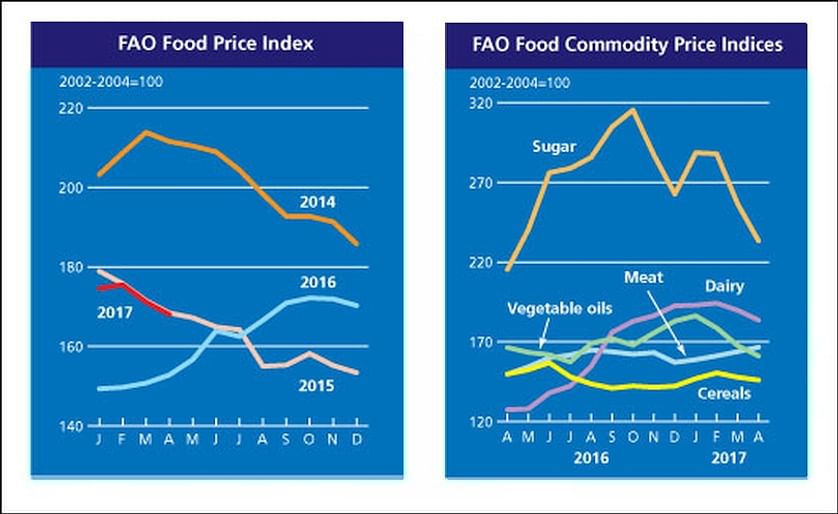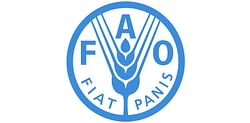The FAO Food Price Index (FFPI) averaged 168.0 points in April 2017, down 3.1 points (1.8 percent) from March, but still 15.2 points (10 percent) higher than in April 2016.
FAO Food Price Index in April down for the third consecutive month

The FAO Food Price Index (FFPI) averaged 168.0 points in April 2017, down 3.1 points (1.8 percent) from March, but still 15.2 points (10 percent) higher than in April 2016. As in March, all commodity indices used in the calculation of the FFPI subsided in April, with the exception of meat values.
The FAO Cereal Price Index averaged 146.0 points in April, down 1.8 points (1.2 percent) from the previous month and 3.8 points (2.5 percent) from its value in April 2016. Strong export competition and expectations that global cereal availabilities will remain ample in the 2017/18 season continued to weigh on international prices of most cereals, wheat in particular. International rice prices, by contrast, firmed in April, buoyed by a more upbeat pace of sales, especially to Near Eastern buyers.
The FAO Vegetable Oil Price Index averaged 161.1 points in April, down 6.6 points (or 3.9 percent) from March – declining for the third consecutive month and marking a 9-month low. The drop mainly reflects lower palm and soyoil prices. Palm oil quotations fell to their lowest level since July 2016, fuelled by a prospective production rebound in Southeast Asia and persistently weak global import demand. Soyoil prices, on the other hand, continued to lose ground following reports of bumper soy harvests in South America and forecasts of all-time high 2017/18 plantings in the United States.
The FAO Dairy Price Index averaged 183.6 in April, down 6.2 points (3.3 percent) from March, representing the second consecutive month of decline. Ample milk supplies, as production in the northern hemisphere has entered its seasonal peak, allayed immediate sourcing concerns and raised expectations of increased production of milk powders and cheese. In contrast to the other dairy commodities, butter prices firmed, as expanding domestic demand in Europe and North America reduced export availabilities.
The FAO Meat Price Index averaged 166.6 points in April, up 2.8 points (1.7 percent) from March, continuing a trend of modest increases evident since the start of the year. From January to April, the Index rose by almost 5 percent. Quotations for ovine and pig meat firmed, while those of bovine and poultry meat were almost unchanged. Strong domestic demand in the EU, combined with increased sales to China and the Republic of Korea, stimulated pig meat prices. Seasonal demand bolstered ovine quotations, while poultry and bovine meat markets remained well balanced.
The FAO Sugar Price Index averaged 233.3 points in April, down 23.3 points (9.1 percent) from March and hitting a twelve-month low. Continued weak global import demand and prospects of larger export supplies from Brazil are among the main factors behind the price decline in April.
The FAO Cereal Price Index averaged 146.0 points in April, down 1.8 points (1.2 percent) from the previous month and 3.8 points (2.5 percent) from its value in April 2016. Strong export competition and expectations that global cereal availabilities will remain ample in the 2017/18 season continued to weigh on international prices of most cereals, wheat in particular. International rice prices, by contrast, firmed in April, buoyed by a more upbeat pace of sales, especially to Near Eastern buyers.
The FAO Vegetable Oil Price Index averaged 161.1 points in April, down 6.6 points (or 3.9 percent) from March – declining for the third consecutive month and marking a 9-month low. The drop mainly reflects lower palm and soyoil prices. Palm oil quotations fell to their lowest level since July 2016, fuelled by a prospective production rebound in Southeast Asia and persistently weak global import demand. Soyoil prices, on the other hand, continued to lose ground following reports of bumper soy harvests in South America and forecasts of all-time high 2017/18 plantings in the United States.
The FAO Dairy Price Index averaged 183.6 in April, down 6.2 points (3.3 percent) from March, representing the second consecutive month of decline. Ample milk supplies, as production in the northern hemisphere has entered its seasonal peak, allayed immediate sourcing concerns and raised expectations of increased production of milk powders and cheese. In contrast to the other dairy commodities, butter prices firmed, as expanding domestic demand in Europe and North America reduced export availabilities.
The FAO Meat Price Index averaged 166.6 points in April, up 2.8 points (1.7 percent) from March, continuing a trend of modest increases evident since the start of the year. From January to April, the Index rose by almost 5 percent. Quotations for ovine and pig meat firmed, while those of bovine and poultry meat were almost unchanged. Strong domestic demand in the EU, combined with increased sales to China and the Republic of Korea, stimulated pig meat prices. Seasonal demand bolstered ovine quotations, while poultry and bovine meat markets remained well balanced.
The FAO Sugar Price Index averaged 233.3 points in April, down 23.3 points (9.1 percent) from March and hitting a twelve-month low. Continued weak global import demand and prospects of larger export supplies from Brazil are among the main factors behind the price decline in April.
Source
FAO




